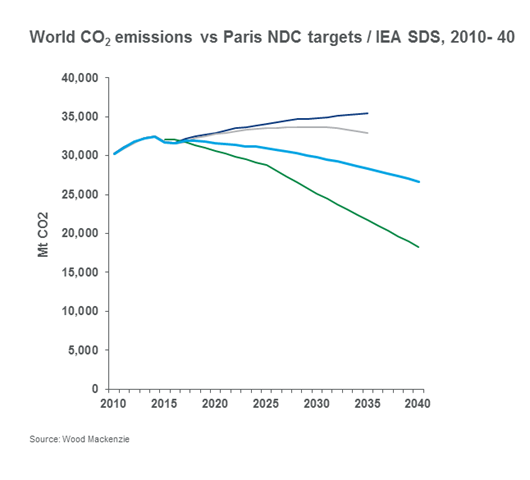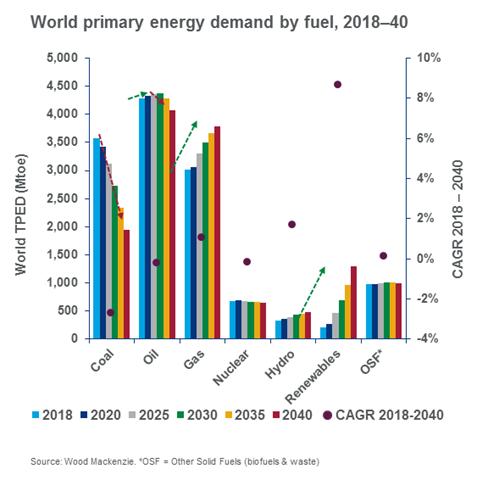What if the energy transition accelerates?
And what that could mean for renewables, coal, oil, gas and emissions
1 minute read
Simon Flowers
Chairman, Chief Analyst and author of The Edge

Simon Flowers
Chairman, Chief Analyst and author of The Edge
Simon is our Chief Analyst; he provides thought leadership on the trends and innovations shaping the energy industry.
Latest articles by Simon
-
The Edge
How and why big oil is strengthening its oil and gas exposure
-
The Edge
Is net zero by 2050 at risk?
-
The Edge
Can emissions taxes decarbonise the LNG industry?
-
The Edge
Why the transition needs smart upstream taxes
-
The Edge
Can carbon offsets deliver for oil and gas companies?
-
Featured
Wood Mackenzie 2023 Research Excellence Awards
Slowly but surely the energy mix is changing. Renewables, increasing efficiency, electrification of end-use demand including electric vehicles (EVs) are driving the energy transition. Even so, we’ll depend on coal, oil and gas for quite some time. Demand for fossil fuels continues to rise for the next two decades at least in our base case forecasts and the share of global energy demand stays above 70% through until 2040. But what if it happens a lot faster? Simon Flowers investigates.
Our Carbon Constrained Scenario envisages a world in which existing and viable technology trends accelerate, steer policy, and become bound together to shape far faster cuts to carbon emissions than we see today under current pledges. I talked through the implications for the energy mix with David Brown, senior cross commodities analyst. Read the transcript of our discussion below.
A carbon-constrained scenario
Navigating a challenging path to lower global emissions
Purchase the carbon-constrained scenario analysisDavid, rapid decarbonisation must be great news for renewables?
Yes – the uptake would be explosive. The electrification of demand across all regions drives power demand at nearly 2% per year through 2040. Wind and solar capacity grows nine-fold from over 900 GW today to just under 8,000 GW by 2040; renewables jumps from 7% of global power output to 40%. It’s transformational. Large-scale energy storage isn’t commercial today, but we’d need 780GW of storage capacity by 2040.
And the big loser?
Coal is the first casualty of decarbonisation. Coal demand halves by 2040 even with no international CO2 pricing regime as the power sector switches to gas and renewables. That’s wildly different to our base case where coal demand stays broadly flat. India is the only major consumer in the Scenario where we see demand for coal increase through 2040. We don’t see carbon capture and storage playing a big role.
What about oil?
A faster energy transition takes a chunk out of oil demand by 2040. We forecast demand peaks at 110 million b/d in 2036 in our base case, with 5.5 million barrels a day lost to EVs. But demand from petrochemicals continues to grow leaving total demand still at that level in 2040. The Carbon Constrained Scenario has two main effects. First, higher EV sales penetration would wipe another 5.5 million b/d off demand. Second, mounting environmental concerns prompt higher biofuel mandates and a challenge to the widespread use of plastics. More biofuels, less single use plastics, and more plastics recycling takes out another 5 million b/d. So oil demand falls to 100 million b/d by 2040, back to today’s level, and on the slide.
Is gas the bridging fuel we think it is?
Demand grows through 2040, but at a slower rate. Power is the big market, gas benefiting from the switch out of coal because of its lower carbon intensity; and provides the flexibility to balance intermittent solar and wind power. Gas has a lot of running room in markets with high power demand growth like China, India and SE Asia – 60% of incremental demand 2018-40 is from Asia-Pacific economies. But in slower-growing power markets like the EU and USA with high penetration of renewables, gas demand growth will be more limited.
Does nuclear fit in?
Nuclear just about holds its own, despite being a zero carbon source of power. Growth in capacity in developing economies like China and India is countered by the EU and North America which have fallen out of love with nuclear. High cost is a factor.
And what does this all do to CO2 emissions?
Emissions fall much faster than under our base case and go beyond the Paris Agreement NDCs at the global level. OECD emissions continue to decline given modest energy demand growth and fuel switching. Developing economies’ emissions peak in the late 2020s then decline as substitution away from coal gathers momentum. Reduction of coal-fired power is the single biggest contributor to the emissions decline.
But the Carbon Constrained scenario still falls well short of the ‘2 degrees Celsius world’ of the IEA SDS trajectory. To get there will need much more to happen beyond the power sector, including: deep decarbonisation of industry, transport and other sectors; accelerated reduction in battery costs; and high-cost, as yet commercially unproven technology such as carbon capture and storage.



